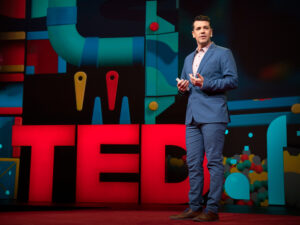Referencing sources accurately is crucial for academic writing, ensuring that original authors receive proper credit and enabling readers to trace the origins of information. TED Talks, which are influential and widely used as educational resources, often require citation in academic papers.
The American Psychological Association (APA) provides specific guidelines for referencing such multimedia sources. This guide, titled “How to Reference a TED Talk in APA,” will outline the steps and formats needed to correctly cite TED Talks in your research papers, ensuring adherence to APA standards.
Educational value of TED Talks

TED Talks have become a significant resource in modern education, offering a unique blend of expertise, inspiration, and accessibility. These short, powerful talks cover a vast array of topics, ranging from science and technology to art and global issues, making them a valuable tool for both teachers and students.
Here are some key aspects of the educational value of TED Talks:
- Expert Insights: TED Talks feature leading experts and innovators from various fields, providing firsthand knowledge and cutting-edge information. This direct access to expert insights can enhance the learning experience by presenting complex concepts in an engaging and understandable manner.
- Diverse Perspectives: The diversity of speakers and topics on TED Talks exposes learners to a wide range of viewpoints and cultures, promoting a broader understanding of the world. This diversity encourages critical thinking and open-mindedness, essential skills in today’s globalized society.
- Engaging Content: TED Talks are designed to be engaging and thought-provoking, often using storytelling and visual aids to make the content more relatable and memorable. This engaging format can help to maintain students’ interest and motivation, making learning more effective.
- Accessibility: With free access to a vast library of talks online, TED Talks democratize education by making high-quality content available to anyone with an internet connection. This accessibility is particularly beneficial for those who may not have access to traditional educational resources.
- Interdisciplinary Learning: TED Talks often explore the intersections between different disciplines, encouraging interdisciplinary learning. This approach helps students see the connections between various fields of study, fostering a more integrated and holistic understanding of knowledge.
- Real-World Applications: Many TED Talks focus on real-world issues and solutions, bridging the gap between theoretical knowledge and practical application. This relevance to real-life challenges can inspire students to think about how they can apply their learning to make a positive impact in the world.
Also, TED Talks offer significant educational value by providing expert insights, diverse perspectives, engaging content, and accessible learning opportunities. Their interdisciplinary and real-world focus further enhances their relevance in contemporary education, making them an invaluable resource for both educators and learners.
Understanding APA Citation Style
The American Psychological Association (APA) citation style is widely used in academic writing, particularly in the social sciences. It provides a standardized method for citing sources, ensuring clarity, consistency, and credibility in scholarly communication. Here’s an overview of the key elements of APA citation style:
1. In-Text Citations
In-text citations in APA format are concise and provide just enough information to direct the reader to the corresponding entry in the reference list. The basic format includes the author’s last name and the publication year, enclosed in parentheses. For example:
- Single Author: (Smith, 2020)
- Two Authors: (Smith & Jones, 2020)
- Three or More Authors: (Smith et al., 2020)
2. Reference List
The reference list at the end of the document provides full details of all sources cited in the text. Each entry includes the author(s), publication year, title of the work, and publication details. The entries are organized alphabetically by the authors’ last names. Key components include:
- Books: Author, A. A. (Year). Title of work: Capital letter also for subtitle. Publisher.
- Journal Articles: Author, A. A. (Year). Title of article. Title of Periodical, volume number(issue number), pages. https://doi.org/xx.xxx/yyyy
- Webpages: Author, A. A. (Year, Month Day). Title of webpage. Website Name. URL
3. Formatting Titles
APA style has specific rules for capitalizing and formatting titles:
- Books and Articles: Only the first word of the title, the first word after a colon or dash, and proper nouns are capitalized. Titles of books and reports are italicized.
- Journal Articles: Titles of journal articles are not italicized or placed in quotation marks, but the title of the journal is italicized and capitalized in title case.
4. DOIs and URLs
Digital Object Identifiers (DOIs) and URLs are essential for providing direct access to online sources:
- DOIs: Always include the DOI for journal articles if available. Format it as a clickable link: https://doi.org/xx.xxx/yyyy
- URLs: For online resources, include the URL of the webpage. Ensure it is a stable and permanent link.
5. Multiple Authors
When citing works by multiple authors, the formatting varies based on the number of authors:
- Two Authors: Include both names separated by an ampersand (&) in in-text citations and references.
- Three to Twenty Authors: List all authors in the reference list. Use an ampersand before the last author.
- More than Twenty Authors: List the first 19 authors, followed by an ellipsis (…), and then the final author’s name.
6. Special Cases
APA style also provides guidelines for citing unusual sources, such as TED Talks, social media posts, and personal communications. For example, a TED Talk citation in the reference list would look like:
- Speaker, A. A. (Year, Month Day). Title of talk [Video]. TED Conferences. URL
Understanding and correctly applying APA citation style is crucial for academic writing. It ensures that sources are properly credited, which helps to avoid plagiarism and allows readers to locate the original sources. By following APA guidelines for in-text citations and the reference list, writers can maintain a professional and credible academic standard.
Types of TED Talks

TED Talks cover a wide array of topics and fall into several categories. These categories are designed to address different interests, issues, and audiences. Here are some of the main types of TED Talks:
- Technology: These talks focus on the latest advancements in technology, showcasing innovative ideas, gadgets, and breakthroughs. Examples include talks on artificial intelligence, robotics, and software development.
- Entertainment: Talks in this category often feature performances, creative projects, and insights into the entertainment industry. They can include music, dance, storytelling, and insights from filmmakers, artists, and entertainers.
- Design: Design talks cover a range of topics from architecture and product design to user experience and graphic design. They often highlight creative processes and the impact of design on our lives.
- Business: These talks provide insights into entrepreneurship, leadership, management, and business strategies. Speakers often share personal stories of success and failure, innovative business models, and trends in the corporate world.
- Science: Talks in this category explore scientific discoveries, research, and theories. They can cover topics from biology and physics to environmental science and space exploration.
- Global Issues: These talks address pressing global challenges such as climate change, poverty, human rights, and international relations. They aim to raise awareness and inspire action.
- Personal Growth: Personal growth talks focus on self-improvement, mental health, motivation, and life skills. Speakers share personal experiences and practical advice to help others lead more fulfilling lives.
- Education: Education talks explore innovative teaching methods, educational technologies, and the importance of lifelong learning. They often feature educators, researchers, and students.
- Health: Health talks cover topics related to physical and mental well-being, medical advancements, and healthcare systems. They can range from discussions on diet and exercise to cutting-edge medical treatments.
- Social Issues: These talks delve into societal issues such as gender equality, race relations, and social justice. They aim to foster understanding and encourage societal change.
- Art: Art talks celebrate creativity and the arts, featuring artists, musicians, writers, and performers. They explore the impact of art on culture and society.
- History: History talks offer insights into historical events, figures, and periods, often drawing connections to contemporary issues and lessons for the future.
- Philosophy: Talks in this category tackle big questions about life, existence, ethics, and human nature. Philosophers and thinkers share their perspectives and invite the audience to ponder deeper meanings.
- Adventure: Adventure talks share stories of exploration, travel, and extraordinary experiences. They often feature adventurers, explorers, and athletes who push the boundaries of what is possible.
- Innovation: Innovation talks highlight groundbreaking ideas and novel approaches in various fields. They focus on creativity, problem-solving, and forward-thinking solutions.
These categories reflect the diversity of topics and the broad appeal of TED Talks, catering to a wide audience with varying interests and passions.
How to reference a ted talk apa
Here’s a step-by-step guide on how to reference a TED Talk in APA format:
- Speaker’s Name: Start with the speaker’s last name followed by their first initial. If the speaker is an organization, use the organization’s name.
- Publication Date: Include the year and month of publication of the TED Talk. If the month is unknown, just include the year.
- Title of the Talk: Provide the title of the TED Talk. Capitalize the first letter of the first word, proper nouns, and the first word after a colon or dash. Enclose the title in square brackets.
- Medium: Indicate the medium of the TED Talk, which is typically “[Video]”.
- Publisher: Specify TED Conferences as the publisher.
- URL: Provide the URL where the TED Talk can be accessed. If you accessed the TED Talk from a different platform (e.g., YouTube), use the URL of that platform.
Here’s an example of how to reference a TED Talk in APA format:
- Speaker’s Name: Pink, D. H.
- Publication Date: (2009, July).
- Title of the Talk: [The puzzle of motivation].
- Medium: [Video].
- Publisher: TED Conferences.
- URL: https://www.ted.com/talks/dan_pink_on_motivation
Combining all these elements, the complete APA reference for the TED Talk would be:
Pink, D. H. (2009, July). [The puzzle of motivation] [Video]. TED Conferences. https://www.ted.com/talks/dan_pink_on_motivation
Ensure that you follow APA guidelines for capitalization, punctuation, and formatting throughout the reference.
Common Mistakes to Avoid

When citing a TED Talk in APA format, avoiding common mistakes is crucial for ensuring the accuracy and professionalism of your reference. Here are some key mistakes to watch out for:
- Incorrect Order of Elements:
- Incorrect Speaker’s Name Format:
- Use only the last name and first initials.
- Incorrect: Daniel H. Pink
- Correct: Pink, D. H.
- Incorrect Date Format:
- Include both the year and the month of the talk.
- Incorrect: (2009)
- Correct: (2009, July)
- Incorrect Title Capitalization:
- Use sentence case for the title (capitalize only the first word and proper nouns).
- Incorrect: The Puzzle of Motivation
- Correct: The puzzle of motivation
- Incorrect Medium Indication:
- Indicate the medium as [Video].
- Incorrect: [TED Talk]
- Correct: [Video]
- Incorrect Publisher Name:
- Use “TED Conferences” as the publisher.
- Incorrect: TED.com
- Correct: TED Conferences
- Incorrect or Missing URL:
- Omitting the Medium:
Example of a Correct APA Citation for a TED Talk
Pink, D. H. (2009, July). The puzzle of motivation [Video]. TED Conferences. https://www.ted.com/talks/dan_pink_on_motivation
By carefully following these guidelines and avoiding common mistakes, you can ensure that your TED Talk citations are correct and in line with APA standards.
Conclusion
You can learn How to Reference a TED Talk in APA on this page. When referencing a TED Talk in APA format, include the following elements: the speaker’s name, the year of the talk, the title of the talk in italics, the description “[Video],” the website name, and the URL




